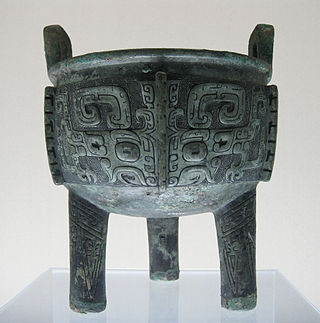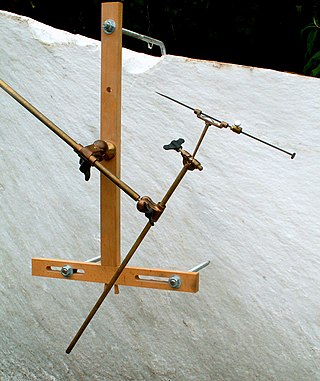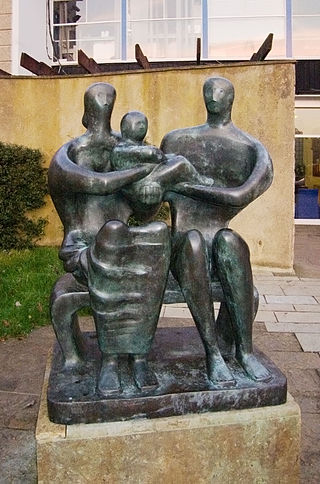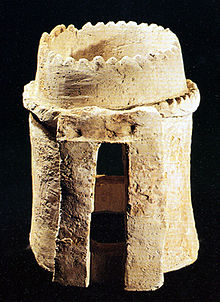
In metalworking and jewelry making, casting is a process in which a liquid metal is delivered into a mold that contains a negative impression of the intended shape. The metal is poured into the mold through a hollow channel called a sprue. The metal and mold are then cooled, and the metal part is extracted. Casting is most often used for making complex shapes that would be difficult or uneconomical to make by other methods.

Terracotta, terra cotta, or terra-cotta, in its material sense as an earthenware substrate, is a clay-based unglazed or glazed ceramic where the fired body is porous.

Plaster is a building material used for the protective or decorative coating of walls and ceilings and for moulding and casting decorative elements. In English, "plaster" usually means a material used for the interiors of buildings, while "render" commonly refers to external applications. Another imprecise term used for the material is stucco, which is also often used for plasterwork that is worked in some way to produce relief decoration, rather than flat surfaces.

Bronze is the most popular metal for cast metal sculptures; a cast bronze sculpture is often called simply "a bronze". It can be used for statues, singly or in groups, reliefs, and small statuettes and figurines, as well as bronze elements to be fitted to other objects such as furniture. It is often gilded to give gilt-bronze or ormolu.

Stone carving is an activity where pieces of rough natural stone are shaped by the controlled removal of stone. Owing to the permanence of the material, stone work has survived which was created during our prehistory or past time.

Papier-mâché is a composite material consisting of paper pieces or pulp, sometimes reinforced with textiles, bound with an adhesive, such as glue, starch, or wallpaper paste.

Lost-wax casting is the process by which a duplicate metal sculpture is cast from an original sculpture. Intricate works can be achieved by this method.
Spin casting, also known as centrifugal rubber mold casting (CRMC), is a method of utilizing inertia to produce castings from a rubber mold. Typically, a disc-shaped mold is spun along its central axis at a set speed. The casting material, usually molten metal or liquid thermoset plastic, is then poured in through an opening at the top-center of the mold. The filled mold then continues to spin as the metal solidifies.

Electrotyping is a chemical method for forming metal parts that exactly reproduce a model. The method was invented by Moritz von Jacobi in Russia in 1838, and was immediately adopted for applications in printing and several other fields. As described in an 1890 treatise, electrotyping produces "an exact facsimile of any object having an irregular surface, whether it be an engraved steel- or copper-plate, a wood-cut, or a form of set-up type, to be used for printing; or a medal, medallion, statue, bust, or even a natural object, for art purposes."

Lifecasting is the process of creating a three-dimensional copy of a living human body, through the use of molding and casting techniques. In rare cases lifecasting is also practiced on living animals. The most common lifecasts are of torsoes, pregnant bellies, hands, faces, and genitalia and it is possible for an experienced lifecasting practitioner to copy any part of the body. Lifecasting is usually limited to a section of the body at a time, but full-body lifecasts are achievable too. Compared with other three-dimensional representations of humans, the standout feature of lifecasts is their high level of realism and detail. Lifecasts can replicate details as small as fingerprints and pores.

The Louis Riel sculpture is a monument to Louis Riel located on the grounds of the Manitoba Legislative Building in Winnipeg. Commissioned by the Manitoba Metis Federation (MMF) and sculpted by Miguel Joyal, the statue is located on the building's south grounds and faces the Assiniboine River.

A pointing machine is a measuring tool used by stone sculptors and woodcarvers to accurately copy plaster, clay or wax sculpture models into wood or stone. In essence the device is a pointing needle that can be set to any position and then fixed. It further consists of brass or stainless steel rods and joints which can be placed into any position and then tightened. It is not actually a machine; its name is derived from the Italian macchinetta di punta. The invention of the tool has been ascribed to both the French sculptor and medallist Nicolas-Marie Gatteaux (1751–1832) and to the British sculptor John Bacon (1740–1799). It was later perfected by Canova. However, similar devices were used in ancient times, when the copying of Greek sculptures for the Roman market was a large industry.

Casting is a manufacturing process in which a liquid material is usually poured into a mold, which contains a hollow cavity of the desired shape, and then allowed to solidify. The solidified part is also known as a casting, which is ejected or broken out of the mold to complete the process. Casting materials are usually metals or various time setting materials that cure after mixing two or more components together; examples are epoxy, concrete, plaster and clay. Casting is most often used for making complex shapes that would be otherwise difficult or uneconomical to make by other methods. Heavy equipment like machine tool beds, ships' propellers, etc. can be cast easily in the required size, rather than fabricating by joining several small pieces. Casting is a 7,000-year-old process. The oldest surviving casting is a copper frog from 3200 BC.

Forest Idyl is a bronze statue created in 1924 by Albin Polasek while he was head of the Sculpture Department at the Art Institute of Chicago. There are several copies of three versions of the sculpture, the locations of which are Brookgreen Gardens in South Carolina; three in Winter Park, Florida, at the Albin Polasek Museum & Sculpture Gardens and at City Hall; and in Muncie, Indiana, at Ball State University.

Spindle Piece is a bronze sculpture series by Henry Moore. Unusually, the sculpture was made in four sizes: a plaster maquette cast in bronze as Maquette for Spindle Piece in 1968, a larger plaster working model which was also cast in bronze as Spindle Piece in 1968, a larger series of bronze sculptures Large Spindle Piece cast in 1974, and the largest model, known as The Spindle, carved in travertine in 1981.
Meridian is a bronze sculpture by British artist Barbara Hepworth. It is an early example of her public commissions, commissioned for State House, a new 16-storey office block constructed at 66–71 High Holborn, London, in the early 1960s. The sculpture was made in 1958–59, and erected in 1960. When the building was demolished in 1990, the sculpture was sold and moved to the Donald M. Kendall Sculpture Gardens in Purchase, New York.

Family Group is a sculpture by Henry Moore. It was his first large-scale bronze sculpture, and his first large bronze with multiple castings. Made for Barclay School in Stevenage, it evolved from drawings in the 1930s, through a series of models to bronze castings in 1950–51. It also one of the last important sculptures that Moore developed from preliminary drawings: in future, he worked mainly from found objects, maquettes and models.

UNESCO Reclining Figure 1957–58 is a sculpture by Henry Moore. It was made in a series of scales, from a small plaster maquette, through a half-size working model made in plaster and cast in bronze, to a full-size version carved in Roman travertine marble in 1957–1958. The final work was installed in 1958 at the World Heritage Centre, the headquarters of UNESCO at the Place de Fontenoy in Paris. This was Moore's last major public commission in which he created a new work for a specific site; he afterwards generally worked from an existing sketch or model.
Reclining Figure is a statue by Henry Moore. The original two-part bronze statue of a human figure was commissioned for the Lincoln Center for the Performing Arts in New York City, where it has been displayed outdoors since 1965 in a pool of water to the north of the new Metropolitan Opera House. Other copies in plaster or bronze exist, and are displayed in other cities.

Locking Piece is a sculpture by Henry Moore. It comprises two interlocking forms holding a third element between them, on a bronze base. It is usually mounted on a separate plinth. The sculpture was created in 1962–1964, and bronze casts were made in 1964–1967.


















